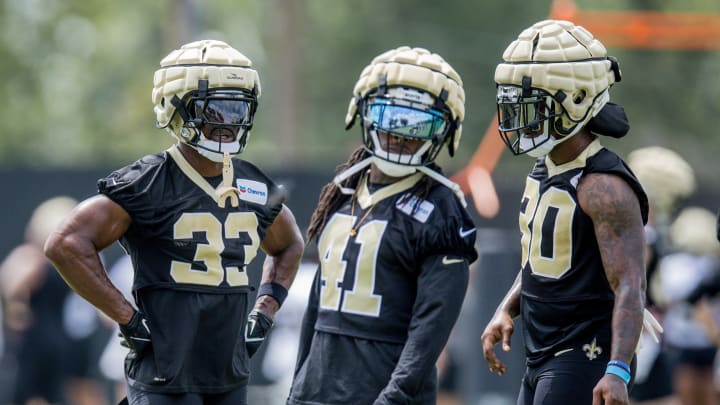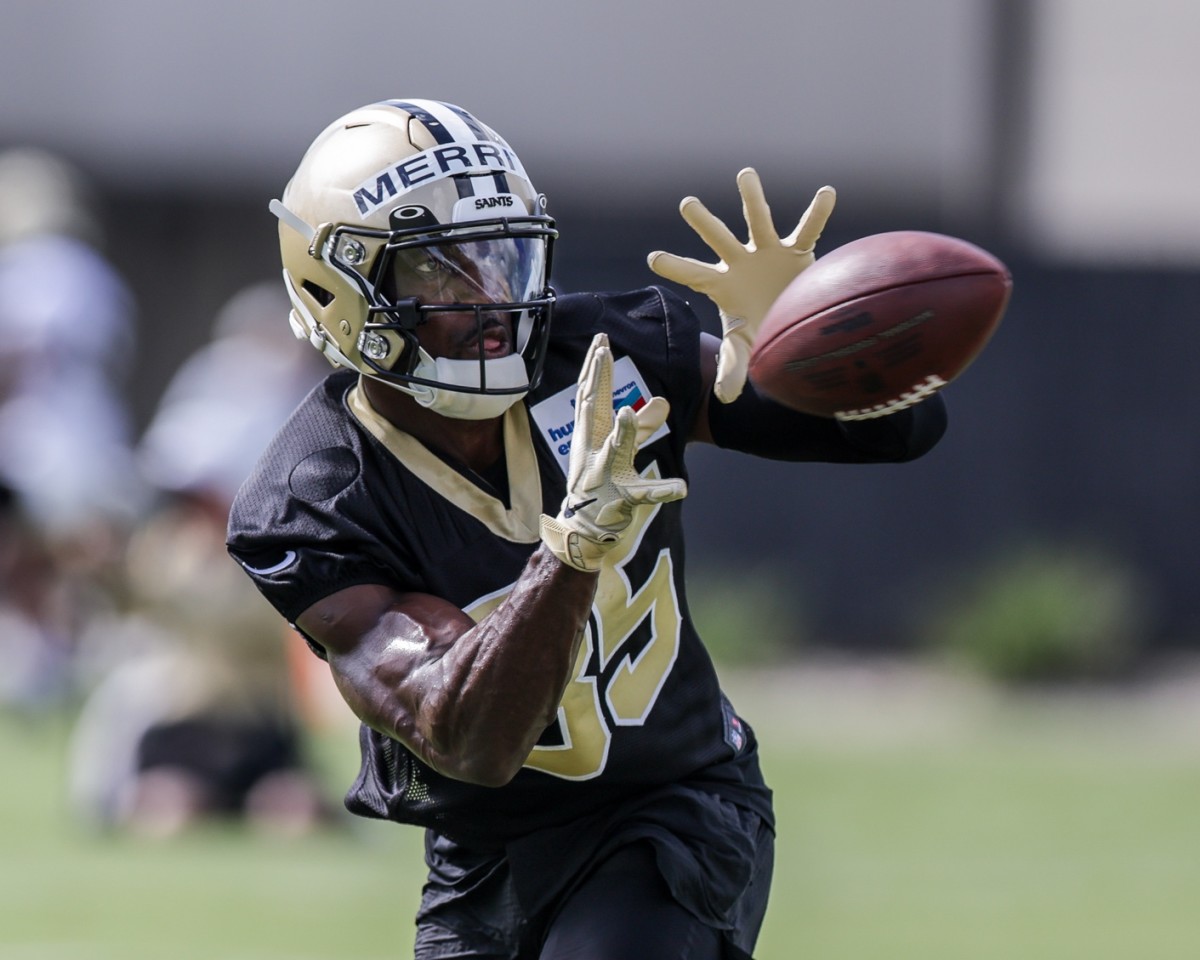Saints Running Back Room Structure Looks Familiar

Across the NFL, the running back position is seeing a massive dip in value. From contracts that come in well below market expectations to a rise in anti-first round running back discourse, the position is one that has been increasingly under fire for some time. However, the New Orleans Saints have not begun to sleep on the group at all, leading to the assembling of an impressive trio, if not more, of backs on the roster.
The committee approach is far from unusual in New Orleans. The team has consistently architected a successful rushing approach around two or more backs for years. Since 2020 though, things have been a bit different. In 2017 and 2018, the Saints built their rushing attack around the tandem of rushers Mark Ingram and Alvin Kamara with additional contributions from third backs like Trey Edmunds and Dwayne Washington.

Similarly in 2019 and 2020, the team's rushing front was built off of two backs, Kamara and veteran rusher Latavius Murray. In this setting, Kamara was given more of a feature role out of the backfield while Murray provided a change of pace as the power and blocking back.
For both Murray and Ingram it was imperative that they also grew as contributors in the passing game as well. Murray added 411 receiving yards and two touchdown catches in his two years while Ingram piled on 586 yards receiving and a lone touchdown reception in 2017 and 2018 combined. Neither back was highly touted as a receiving threat, but things changed when they entered the Saints' system.
Over the last two seasons, Kamara has not had such an impactful second in the backfield. The return of Ingram to New Orleans via trade during the 2021 season was a welcome one, but one that unfortunately did not pan out due to various injuries. New Orleans also tried its luck with undrafted free agent rookie Tony Jones Jr. and versatile back Ty Montgomery among others throughout the seasons. Unfortunately, all finding little or no success.

So what makes the 2023 backfield to different? First off, having adding a proven power rusher like Jamaal Williams was a huge and undervalued acquisition for the team this offseason. The rushing touchdowns leader of 2022 now paired in the backfield with Kamara gives the Saints a shot at a "Boom and Zoom" version 3. But the fun does not stop there.
The second big difference is rookie running back Kendre Miller. The TCU alum gives the Saints a chance to not only have a two-headed attack in the backfield, but at least a three-headed attack, depending on how available each player is throughout the season. Keeping in mind Kamara's potential suspension and Miller's rehabilitation process related to his collegiate MCL sprain.
Despite the availability questions, though. The Saints will build an offseason gameplan around the potential for a three-back approach. Sound like too much? If so, don't worry, New Orleans has done this before.
In several years throughout the team's Sean Payton and Drew Brees era, the team deployed a consistent mix of three backs. Here are a few highlights laid out, their total offensive snap counts, rushing and receiving production for each season.
2009 | Pierre Thomas | Mike Bell | Reggie Bush |
|---|---|---|---|
Offensive Snaps | 458 | 280 | 473 |
Rushing Attempts | 147 | 172 | 35 |
Rushing Yards | 793 | 654 | 125 |
Rushing Touchdowns | 6 | 5 | 2 |
Receiving Yards | 302 | 12 | 335 |
2011 | Darren Sproles | Pierre Thomas | Mark Ingram |
|---|---|---|---|
Offensive Snaps | 596 | 428 | 215 |
Rushing Attempts | 87 | 110 | 122 |
Rushing Yards | 603 | 562 | 474 |
Rushing Touchdowns | 2 | 5 | 5 |
Receiving Yards | 710 | 425 | 46 |
2013 | Pierre Thomas | Mark Ingram | Darren Sproles |
|---|---|---|---|
Offensive Snaps | 565 | 231 | 421 |
Rushing Attempts | 147 | 78 | 53 |
Rushing Yards | 549 | 386 | 220 |
Rushing Touchdowns | 2 | 1 | 2 |
Receiving Yards | 513 | 68 | 604 |
The idea of utilizing three running backs from the backfield no longer feels cumbersome when the team's track record for doing so has been mostly successful. The formula looks to be two all-around backs (take Pierre Thomas and Darren Sproles for instance) who can both be threats as rushers and receivers and a power back like Ingram or Super Bowl champion Mike Bell. Safe to say that the Saints have reloaded on each archetype going in to 2023, maybe even more-so.
If New Orleans achieves its task of further developing both Williams and Miller into greater threats as pass-catchers, they could have three backs that could take the field and threaten defenses in several ways. This may be what the team is hoping to do with this year's assembly of backs.
There is one more interesting piece to all of this that can be uncovered by diving just a bit deeper into the 2011 and 2013 rosters. Each of those teams also had a fourth back that found ways to contribute. In 2011 power-back Chris Ivory was only 100 rushing yards behind Ingram at 374 on 79 carries. While he only crossed the goal line once that season, he averaged an impressive 4.7 yards per carry. Similarly in 2013, running back Khiry Robinson just barely out-rushed Sproles with 224 rushing yards on 54 carries with a lone scoring run.
Neither Ivory nor Robinson finished with a single receiving yard in either season. Believe it or not, the Saints could have their fourth secret weapon out of the backfield loading for 2023. And unlike Ivory and Robinson who did not contribute much as receivers, converted wideout Kirk Merritt absolutely would.

Merritt has spent his entire offseason with the Saints running backs after joining the club as a wide receiver last year. He had a brief taste of running back life last offseason before moving back to his natural position but now looks to be embracing a full-on position change. And that could do wonders for the Saints.
It would be irresponsible to leave versatile back Eno Benjamin out of the conversation as well. He can absolutely also contribute to both elements of the game. The Saints found that out up close and personal. Though both he and Merritt are exciting prospect, showing what they can do on special teams and as pass-blocker may be the separating factor for them to earn roster spots.
New Orleans has its hands full in the running back room with undrafted rookie Ellis Merriweather and a pair of fullbacks to also consider. But the good thing about that is that by loading up the room with so much talent, the team could conceivably roster three, potentially four running backs that could be meaningful contributors in 2023. A blast from the past could be on the way with the team's running backs approach.
